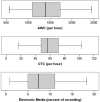Linguistic input, electronic media, and communication outcomes of toddlers with hearing loss
- PMID: 24441740
- PMCID: PMC3944057
- DOI: 10.1097/AUD.0b013e3182a76768
Linguistic input, electronic media, and communication outcomes of toddlers with hearing loss
Abstract
Objectives: The objectives of this study were to examine the quantity of adult words, adult-child conversational turns, and electronic media in the auditory environments of toddlers who are hard of hearing (HH) and to examine whether these factors contributed to variability in children's communication outcomes.
Design: Participants were 28 children with mild to severe hearing loss. Full-day recordings of children's auditory environments were collected within 6 months of their second birthdays by using Language ENvironment Analysis technology. The system analyzes full-day acoustic recordings, yielding estimates of the quantity of adult words, conversational turns, and electronic media exposure in the recordings. Children's communication outcomes were assessed via the receptive and expressive scales of the Mullen Scales of Early Learning at 2 years of age and the Comprehensive Assessment of Spoken Language at 3 years of age.
Results: On average, the HH toddlers were exposed to approximately 1400 adult words per hour and participated in approximately 60 conversational turns per hour. An average of 8% of each recording was classified as electronic media. However, there was considerable within-group variability on all three measures. Frequency of conversational turns, but not adult words, was positively associated with children's communication outcomes at 2 and 3 years of age. Amount of electronic media exposure was negatively associated with 2-year-old receptive language abilities; however, regression results indicate that the relationship was fully mediated by the quantity of conversational turns.
Conclusions: HH toddlers who were engaged in more conversational turns demonstrated stronger linguistic outcomes than HH toddlers who were engaged in fewer conversational turns. The frequency of these interactions was found to be decreased in households with high rates of electronic media exposure. Optimal language-learning environments for HH toddlers include frequent linguistic interactions between parents and children. To support this goal, parents should be encouraged to reduce their children's exposure to electronic media.
Figures



References
-
- American National Standards Institute (ANSI) ANSI S3.22-2003-Specification of hearing aid characteristics. Acoustical Society of America; Melville, NY: 2003.
-
- ANSI . Methods for calculation of the speech intelligibility index. Technical Report S3.5-1997. American National Standards Institute; New York, New York: 1997.
-
- Aragon M, Yoshinaga-Itano C. Using Language ENvironment Analysis to improve outcomes for children who are deaf or hard of hearing. Semin Speech Lang. 2012;33:340–353. - PubMed
-
- Baumwell L, Tamis-LeMonda CS, Bornstein MH. Maternal verbal sensitivity and child language comprehension. Infant Behav Dev. 1997;20:247–258.
Publication types
MeSH terms
Grants and funding
LinkOut - more resources
Full Text Sources
Other Literature Sources
Medical

